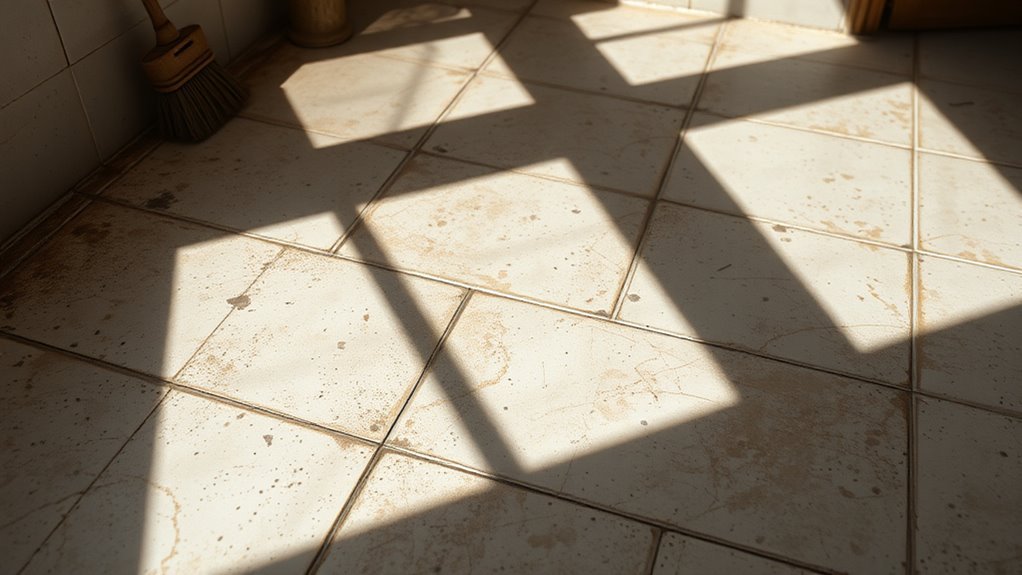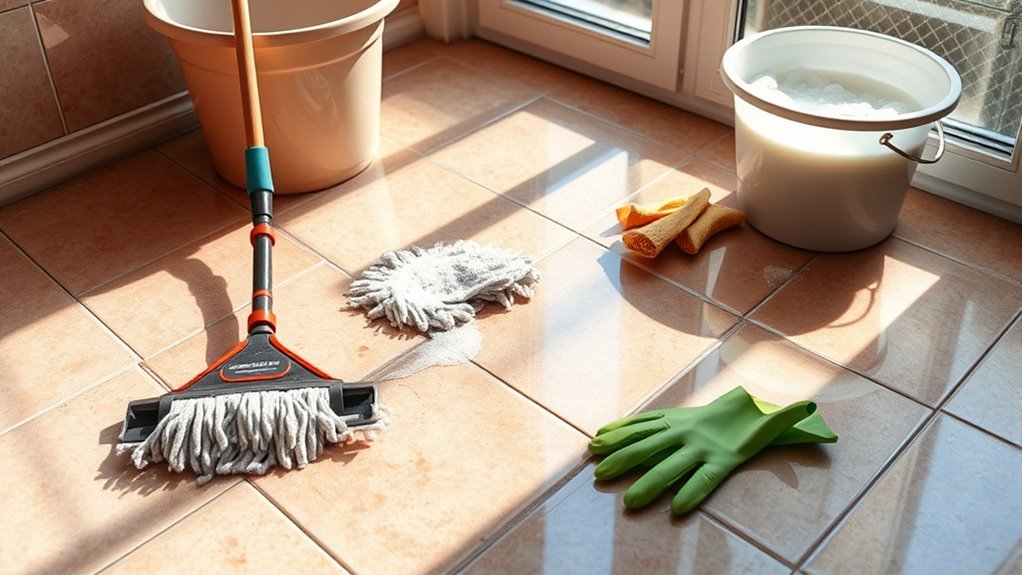Common Mistakes When Cleaning Tile
When cleaning tile, avoid using harsh chemicals that degrade surfaces and applying excessive water that promotes mold and weakens grout. Don’t neglect grout maintenance, as buildup causes discoloration and microbial growth. Stay away from abrasive tools that scratch tiles and maintain a consistent cleaning schedule to prevent stubborn grime. Proper care preserves your tile’s appearance and durability. Understanding these common pitfalls will help you maintain tile effectively and prevent costly damage over time.
Using Harsh Chemicals That Damage Tile Surfaces

Although harsh chemicals might seem effective for cleaning tile, they can actually degrade the surface over time. When you use acidic or abrasive cleaners, the tile’s glaze and finish suffer, leading to dullness and increased susceptibility to damage. To maintain surface protection, it’s essential to choose chemical alternatives designed specifically for tile care. These alternatives often use gentler, pH-neutral formulas that remove dirt without compromising the tile’s integrity. By selecting appropriate products, you preserve both appearance and durability, allowing your tile to withstand daily wear. Embracing safer cleaning methods gives you the freedom to maintain your surfaces confidently, avoiding costly repairs or replacements caused by aggressive chemicals. Prioritize surface protection through informed choices for long-lasting tile beauty.
Ignoring Grout Cleaning and Maintenance
If grout isn’t cleaned and maintained regularly, it can quickly become a breeding ground for mold, mildew, and dirt buildup. Ignoring this critical step leads to grout discoloration causes rooted in accumulated grime and moisture retention. You need to act proactively with effective grout solutions to preserve both aesthetics and hygiene. Neglecting grout maintenance can:
Regular grout care prevents mold, mildew, and discoloration, ensuring lasting cleanliness and tile beauty.
- Compromise your tile’s structural integrity
- Create unsightly stains that resist standard cleaning
- Encourage harmful microbial growth impacting indoor air quality
- Limit your freedom to enjoy a pristine, healthy environment
To avoid these pitfalls, regularly apply specialized grout cleaners and sealants designed for your tile type. This targeted approach guarantees grout longevity and prevents persistent discoloration, empowering you to maintain a fresh, inviting space without hassle.
Applying Excessive Water During Cleaning

One common mistake you might make when cleaning tile is applying excessive water, which can lead to serious damage over time. Over-saturating tiles and grout allows moisture to penetrate beneath the surface, increasing the risk of water damage such as mold growth, staining, and weakening of adhesive materials. To maintain tile integrity, control your cleaning frequency to avoid prolonged exposure to water. Instead of flooding the area, use a damp mop or microfiber cloth with minimal water, ensuring fast drying. This approach prevents water from seeping into grout lines and subflooring, preserving the tile’s durability and appearance. By moderating water use, you maintain freedom from costly repairs and extend the life of your tile surfaces effectively.
Using Abrasive Tools That Scratch Tiles
When cleaning tile, using abrasive tools can cause microscopic scratches that accumulate over time, dulling the surface and compromising its protective glaze. Choosing the right tools is critical for scratching prevention and maintaining your tile’s integrity. Avoid harsh scrub brushes, steel wool, or scouring pads that aggressively abrade the surface. Instead, focus on tool selection that balances cleaning power with gentleness.
To protect your freedom from costly repairs or irreversible damage, consider these guidelines:
Protect your investment by choosing gentle cleaning tools to avoid costly damage and maintain tile beauty.
- Use soft microfiber cloths or non-abrasive sponges
- Employ nylon brushes with soft bristles for grout lines
- Avoid metal scrapers or rough pads that gouge surfaces
- Test tools on a small, inconspicuous area before full use
Thoughtful tool selection guarantees your tile stays pristine while you enjoy effortless cleaning.
Neglecting Regular Cleaning Schedules

Consistency plays an essential role in maintaining tile surfaces, as neglecting regular cleaning schedules allows dirt, grime, and mildew to build up, leading to stains and surface degradation. You need to establish a suitable cleaning frequency based on tile type, location, and foot traffic to prevent damage. Without adhering to this schedule, contaminants embed deeper, making removal harder and potentially causing premature wear. To stay on track, implement schedule reminders via digital calendars or maintenance apps, ensuring you don’t skip critical cleaning intervals. Regular cleaning also preserves grout integrity and prevents microbial growth, which can compromise both aesthetics and health. By prioritizing consistent maintenance, you extend your tiles’ lifespan and retain their original finish, granting you the freedom to enjoy a clean, durable surface without unnecessary repairs or replacements.
Overlooking Proper Tile Sealing Techniques
Maintaining a regular cleaning schedule helps prevent dirt buildup, but without proper sealing, your tiles remain vulnerable to moisture and stains. Overlooking tile sealing can compromise durability, causing grout discoloration and tile damage. Choosing the right sealing products and applying them correctly is vital for long-lasting protection.
To guarantee effective tile sealing, consider these significant factors:
- Selecting sealing products compatible with your tile type
- Thoroughly cleaning tiles before applying sealant
- Applying sealant evenly and allowing adequate drying time
- Reapplying sealant periodically to maintain protection
Frequently Asked Questions
Can Vinegar Damage All Types of Tile Surfaces?
You might find it surprising, but vinegar effects on tile types aren’t always as friendly as you’d hope. While it’s a popular natural cleaner, vinegar can be a bit harsh on sensitive surfaces like natural stone tiles—marble or travertine, for example—causing etching or dullness. However, ceramic and porcelain tiles usually handle vinegar well. So, you’ll want to know your tile’s nature before using vinegar, preserving both beauty and freedom in your cleaning routine.
How Often Should Grout Be Resealed to Prevent Damage?
You should consider grout sealing frequency as typically every 1 to 3 years, depending on wear and exposure to moisture. Regular grout maintenance tips include inspecting grout annually for cracks or discoloration and applying a high-quality sealer to protect against stains and damage. Staying on top of this schedule helps maintain grout integrity and extends your tile’s lifespan, giving you freedom from costly repairs and keeping surfaces looking fresh and durable.
What Is the Best Way to Remove Mold From Tile Grout?
To effectively remove mold from tile grout, you should use specialized mold removal techniques combined with grout cleaning products containing bleach or hydrogen peroxide. Apply the product generously, let it sit for 10-15 minutes, then scrub with a stiff brush to break down mold spores. Rinse thoroughly and dry the area completely to prevent regrowth. Regular maintenance and using mold-resistant sealers afterward can help you maintain a clean, mold-free grout surface.
Are Steam Cleaners Safe for Tile Floors?
Imagine your tile floor gleaming like polished glass, free from dirt and grime. You’ll find steam cleaner effectiveness impressive—it uses high-temperature vapor to lift stubborn stains without harsh chemicals. For tile floor maintenance, steam cleaners are generally safe, especially on glazed tiles, but avoid unsealed or delicate stone tiles to prevent damage. Using this method, you maintain your floors’ freedom from residue while preserving their durability and shine.
How Do Temperature Changes Affect Tile Durability?
Temperature changes can greatly impact tile durability because temperature extremes cause tile expansion and contraction. When tiles expand due to heat, then contract in cold, it stresses the grout and adhesive, potentially leading to cracks or loosening. You’ll want to guarantee proper installation with flexible grout and allow for expansion gaps to accommodate these shifts. Managing temperature variations helps maintain your tile’s integrity, giving you more freedom from costly repairs.






